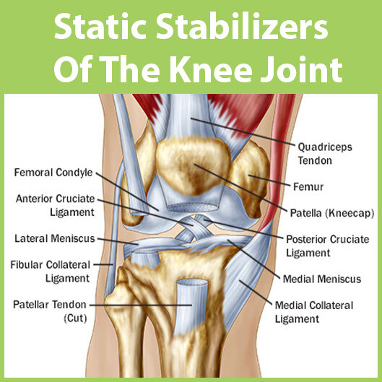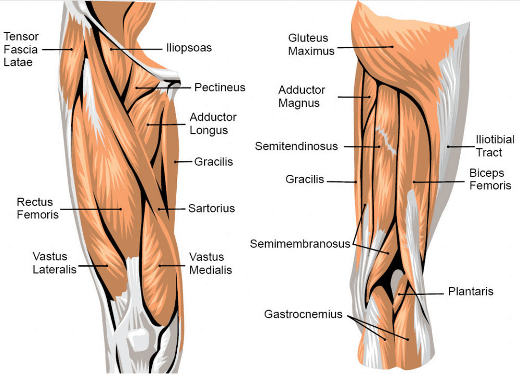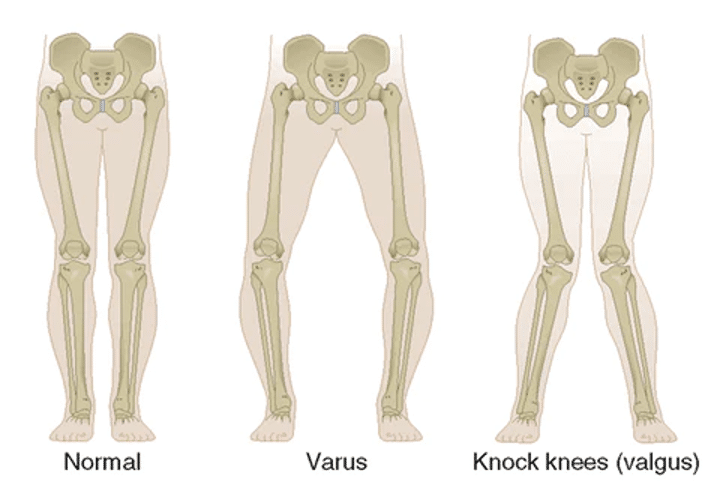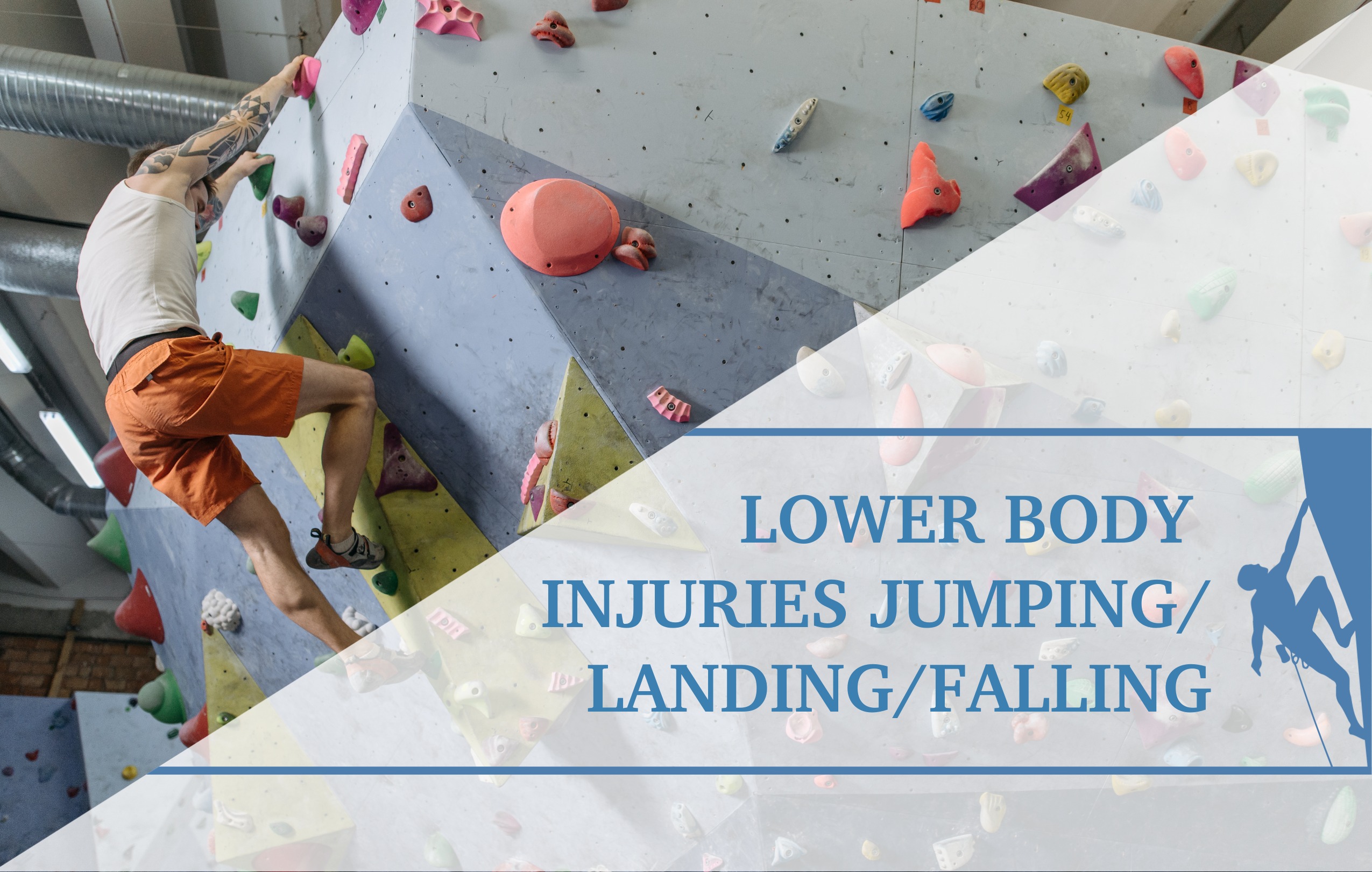Falling with a dodgy knee: A guide to injury prevention and management in boulderers with existing knee problems
For many people who are new to bouldering, falling and jumping off the wall often seems very scary, especially to those who have a “dodgy knee.” We all know that one person who started climbing, but refuses to jump down or commit to risky moves because they do not want to hurt their knees. Being afraid and cautious not to jump off the wall in fear of further injuring your knee is perfectly logical, and in every gym it is always recommended to climb down. However, in reality, if you want to climb hard, it is unavoidable that falls and jumps will happen. This article walks you through everything you need to know to ensure safe landing, including an at-home treatment guide for strengthening your knees. Let’s get started!
Knee Anatomy – Stabilizers
In order to help our knees, we first have to look at the anatomy. Contrary to popular belief, the knee actually consists of two joints: the patellofemoral joint and femorotibial joint and they can move in the sagittal, transverse and frontal plane (Fig 1). The knee connects the tibia and fibula to the femur, forming the longest lever in the body. All these factors make the knees susceptible to injuries (Abulhasan & Grey, 2017), good news is, with appropriate techniques, and strength and conditioning, the risk of injury and re-injury can be reduced.
The knee is stabilized primarily by rigid, fibrous bands that connect bones, called ligaments (Fig 2). While you can’t train your ligaments to be bulletproof, you can with the muscles surrounding the knee joints which also play an important role in knee stabilization (Fg 3). During a fall, surrounding muscles contract to prevent the knee from going over valgus or varus (Fig 4), aiding and protecting the medial and lateral ligaments.
Moreover, during a fall, your leg muscles, especially the knee and hip extensor muscle, contract eccentrically, acting as a decelerator to help control the speed of contact. (Abulhasan & Grey, 2017). This deceleration is not to stop your body from moving entirely, but to reduce the impact on your body. The mechanism is much like putting a heavy bag of groceries down. The bag of groceries is still lowering to the ground, but your muscles help to slow down the speed of it hitting the ground, so your bottle of Rosé won’t smash on the ground.
Figure 1: Static Stabilizers of the Knee

Figure 2: Dynamic Stabilizers of the Knee

During a fall, your muscles contract to prevent your knee from going into valgus (inward) or varus (outward), aiding and protecting the medial and lateral ligaments (Fig 3).
Moreover, during a fall, your leg muscles, especially the knee and hip extensor muscle, contract eccentrically, acting as a decelerator to help control the speed of contact. (Abulhasan & Grey, 2017). This deceleration is not to stop your body from moving entirely, but to reduce the impact on your body. The mechanism is much like putting a heavy bag of groceries down. The bag of groceries is still lowering to the ground, but your muscles help to slow down the speed of it hitting the ground, so your bottle of Rosé won’t smash on the ground.
Figure 3: Normal, Varus, and Valgus Knees

Proprioception – the hidden symptom
There is a wide variety of knee injuries causing people pain and discomfort. One common symptom that many might not be aware of is the decrease in proprioception (Fleming et al., 2021). Proprioception refers to the awareness of the joint position in space, which plays a big part in maintaining body balance. Loss of proprioception can lead to falling with bad technique and subsequently injuries.
Proprioceptors are mini receptors living in your muscles, tendons, and ligaments that make proprioception possible. They can detect abnormal strains in your knee structures, thereby sending feedback to your nervous system, triggering nearby muscles to contract and stabilize the knee joint. This is an automatic reflex much like the famous knee jerk reflex, however this happens on a much smaller scale and is not consciously noticeable. Proprioception is very important to boulderers as a quick reaction in respect to joint position is needed to appropriately absorb the impact of a fall. Hence proprioception is important in your knee injury rehabilitation.
Myth? Jumping is harmful for your knees
It is a common misconception that repetitive jumping will “wear down” your knee and make your knee ache when you are old, however there is currently no strong evidence to support that repetitive jumping will directly increase risk of osteoarthritis[d]. Your knees are more than just hinge joints, they have all the wonderful structures around them to help absorb impact as aforementioned, and of course the soft mats in the bouldering gym add to this absorption as well (Mills et al., 2010).
On the contrary, if you avoid jumping at all cost, imagine what will happen when you commit to the big dyno you’re projecting, but you miss it!… Now you are falling, and your legs might not be quite ready to catch you as you are not used to it!
So what now…?
I believe everyone has watched the “How to fall safely” video in EVERY boulder gym’s safety waiver, but what more can you do except for land-on-both-feet-go-down-on-your-bum-and-roll-backwards? Well, you can train your body to control the fall and be more prepared to absorb the impact. And the more you practice, the better you are at it. This is not because your muscles have memory, but by repetition your neuromuscular pathways between the muscle and brain are reinforced, i.e your brain is able to facilitate the same movement faster and more efficiently (Arumugam et al., 2021).
Treatment
This is a general at-home treatment guide specifically for boulderers who are less confident in jumping off the climbing wall due to their existing knee problem/ prior knee injury. If you have any concerns or current injuries it is best to consult a physiotherapist.
1. Training the Decelerators
To land safely, having strong knee extensors and hip extensors are crucial as they are the main decelerators 1. There are hundreds more of these exercises out there but here are some example exercises to get you started! The exercises are listed in order of difficulty, if the first exercises are too easy then you are ready to move onto the next one.
- Squats (quads and hip extensors) (6-9 reps , 3 sets)
- Start with body weight and progress to weighted squats
- Pistol regression (6-9 reps , 3 sets)
- Try to put as less weight as possible on the supporting leg
- Pistol squats (6-9 reps , 3 sets)
- With balance added to the equation your knee stabilizers will be more challenged, as well as your quads
Eccentric muscle strengthening — squat variations
2. Balance Training (daily)
- Single leg stand 60s

- Single leg stand eyes closed 60s

- Single leg stand on pillow/ balance cushion

3. Plyometrics (Aim to land as quietly as possible)
Plyometrics can help you build back proprioception, challenge your dynamic balance, and improve your overall athleticism and vertical jump! Bonus for anyone struggling with dynos! You can mix and match the below exercise.
- Jump over hurdles with change of directions (3 reps, 3 sets)
- Side to side jump over hurdles (3 reps, 3 sets)
- Lateral skater jump (3 reps, 3 sets)
- Box jump downs with variations (3 reps, 3 sets)
Last but not least, no matter how hard you climb, you should never feel embarrassed to practice controlled falling in the gym. Start with a low height that you are comfortable with first, and gradually progress to a higher height, aiming to jump down controlled from the top of the wall. No off-wall exercises will compare to actually practicing on site, so bring what you have learned at home to your climbing gym!
Take home message
- Jumping down is not inherently damaging to your knee joint and should be practiced with injury prevention in mind
- Proprioceptive training, strength training and plyometric training can help make falling from boulder problems safer and decrease your risk of injury
- Happy falling!
About The Author
Angela Lee is physiotherapist in Norwich, UK. She has been climbing for 6 years and plans to specialize in Musculoskeletal physiotherapy and para-sports. To contact Angela with further enquiries, please email her at angela0818lee@gmail.com.
See a Physiotherapist
This article can only act as a guidance and might not be applicable to everyone. If you have a current knee injury and would like more personal clinical opinion, diagnosis and treatment, see a physiotherapist.

The Research
- Abulhasan, J. and Grey, M. (2017) “Anatomy and physiology of knee stability,” Journal of Functional Morphology and Kinesiology, 2(4), p. 34. Available at: https://doi.org/10.3390/jfmk2040034.
- Arumugam, A. et al. (2021) “Effects of neuromuscular training on knee proprioception in individuals with Anterior Cruciate Ligament Injury: A systematic review and grade evidence synthesis,” BMJ Open, 11(5). Available at: https://doi.org/10.1136/bmjopen-2021-049226.
- Fleming, J.D., Ritzmann, R. and Centner, C. (2021) “Effect of an anterior cruciate ligament rupture on knee proprioception within 2 years after Conservative and Operative Treatment: A systematic review with meta-analysis,” Sports Medicine, 52(5), pp. 1091–1102. Available at: https://doi.org/10.1007/s40279-021-01600-z.
- Mills, C., Yeadon, M.R. and Pain, M.T.G. (2010) “Modifying landing mat material properties may decrease peak contact forces but increase forefoot forces in gymnastics landings,” Sports Biomechanics, 9(3), pp. 153–164. Available at: https://doi.org/10.1080/14763141.2010.524244.
- Tamura, A., Akasaka, K. and Otsudo, T. (2021) “Contribution of lower extremity joints on energy absorption during soft landing,” International Journal of Environmental Research and Public Health, 18(10), p. 5130. Available at: https://doi.org/10.3390/ijerph18105130.
- Disclaimer – The content here is designed for information & education purposes only and the content is not intended for medical advice.




